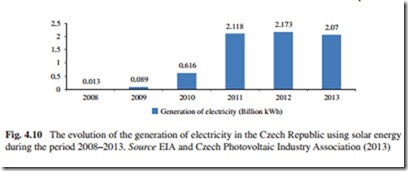Czech Republic
The initial rise in solar PV occurred thanks to massive government incentives in the form of subsidies, fixed purchase prices, and decreasing costs of technology. In 2010, the country’s FiT for solar PV was at 12.15 CZK per kWh, all to achieve the goal of 13 % solar-produced electricity by 2020. In the final year of the boom, the Energy Regulatory Office reported that the Czech Republic stood as the third highest country within the EU in solar PV installations after Germany and Italy.
According to the Global Market Outlook for Photovoltaic until 2015 report, with 1,490 MW recently connected, the Czech Republic was the third largest solar PV market worldwide in 2010, mainly driven by an overly generous FiT scheme.9 However, this unsustainable growth has triggered a strong reaction from the Czech government and grid operators.10 A moratorium was adopted to stop any further grid connections from renewable energy power plants. This moratorium will not be abolished until a vote for improved legislation takes place. The new legislation under preparation, which is likely to impose an obligation of remote supervisory control for installations of over 100 kW, strengthens the permit procedure for systems over 1 MW, sets a FiT ceiling at €248 per MW, and creates new requirements for the recycling of solar PV panels.
The Czech Republic had a target of 2,167 GWh of electricity from solar PV for 2013, a level that had already been surpassed in 2011. The government has therefore announced the discontinuation of FiTs for new solar arrays installed after that year. The brief period of excitement over solar energy in the Czech Republic came to a jarring end in November of 2010 with the approval of a solar tax and a withdrawal of governmental support for large installations. High tariffs coupled with rapid development meant sharp increases in energy costs that pressurized the market. To compensate, the government approved a 26 % tax on solar PV plants producing over 30 kWp and a 28 % levy for green bonuses. According to government sources, it is clearly necessary to set the support for renewables with regard to their impact on end-user electricity price. The increasing number of solar PV plants also means increasing costs of connection to the grid and costs of grid operation.
At the end of 2013, the country had surpassed the 2 GW thresholds, with 2,072 MW of solar PV capacity installed, which represents 10.02 % of the total capacity installed and 50.83 % of the total renewable installed in the country. The Czech Republic occupies the place number ten at world level according to the solar capacity installed (2.07 % of the total) and the place number six at regional level (2.95 % of the regional total). In the past ten years, the solar PV increased in six years within the period considered.
Until today, the Czech Republic has installed solar PV capacity equivalent to around a quarter of its average peak summer demand. Based on figures from neighboring Germany, power production can be expected to peak at around 70 %
of installed capacity, meaning that the Czech Republic will regularly be getting roughly a sixth of its peak power demand in the afternoon from solar PV during the summer.
In terms of volumes for the coming years, the Czech NREAP has set a limit for solar PV at 1,695 MW by 2020, which may already have been surpassed today. A 3.9-GW cumulative installed capacity by 2015 is envisaged, if grid stability concerns are lifted, but this prospect remains far from the current reality.
Electricity Generation Using Solar Energy
The evolution of the generation of electricity in the Czech Republic using solar energy during the period 2008–2013 is shown in Fig. 4.10. According to that figure, the generation of electricity in the Czech Republic using solar energy in the period considered increased 159-fold. However, the Czech Republic’s boom is a story from the past, and the market only reached 88-MW new solar PV capacity installed in 2013, significantly below the 2012 level when 116 MW was installed. The generation of electricity using solar PV in 2013 dropped 9.5 % with respect to 2012. This was the first time that the generation of electricity using solar PV in the Czech Republic decreased in the past years.
